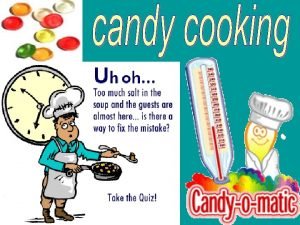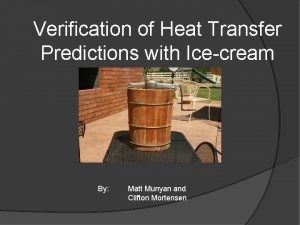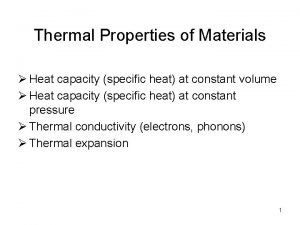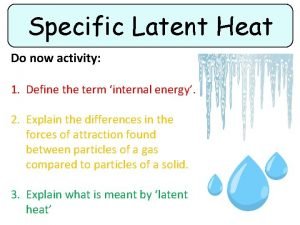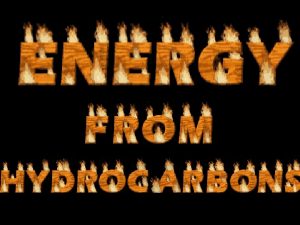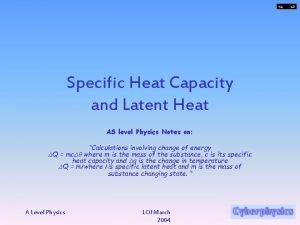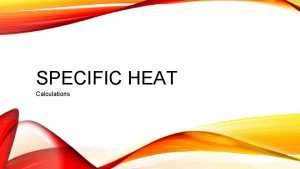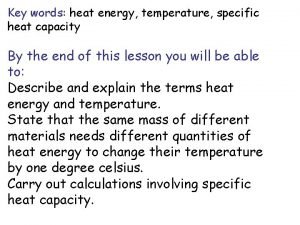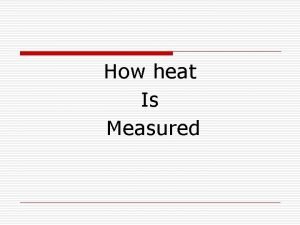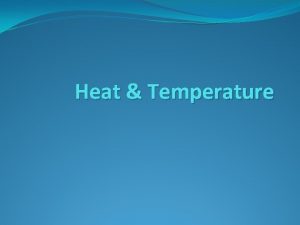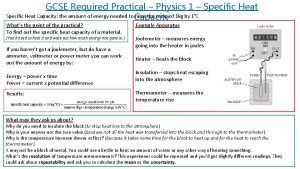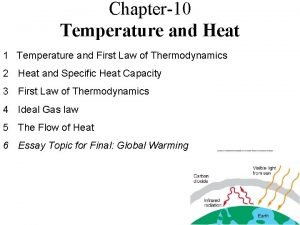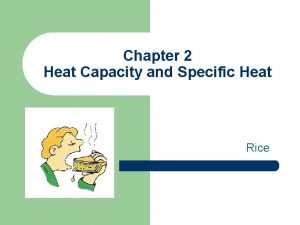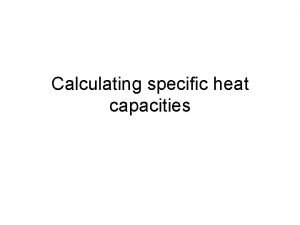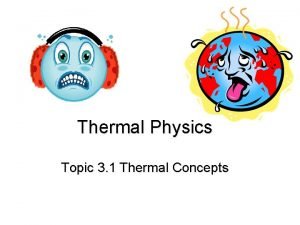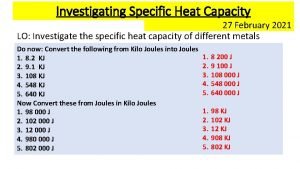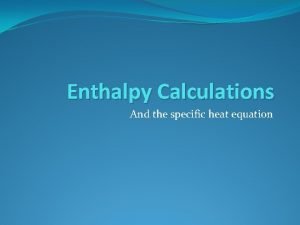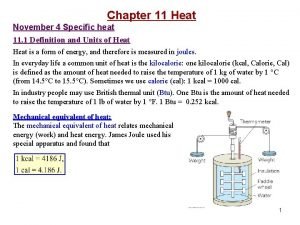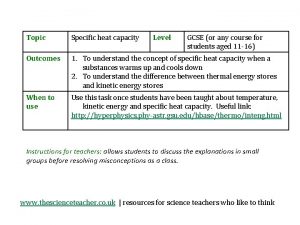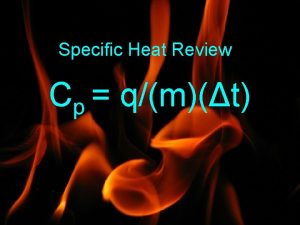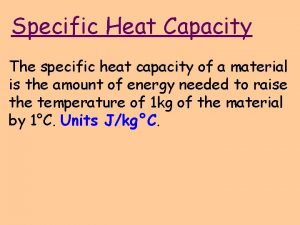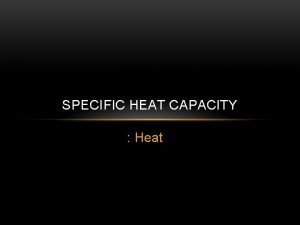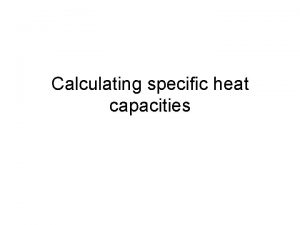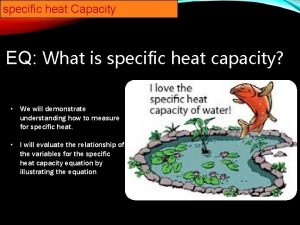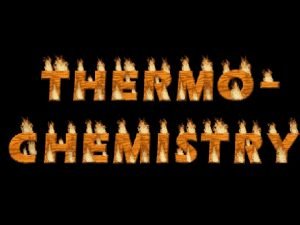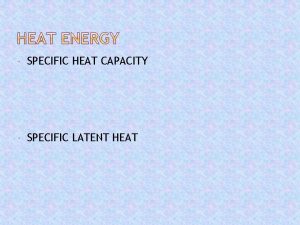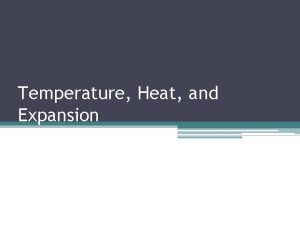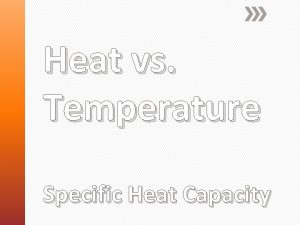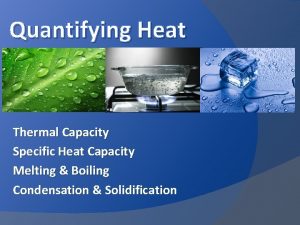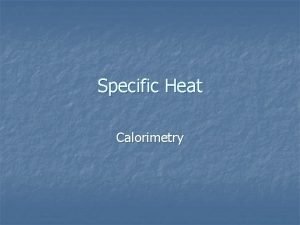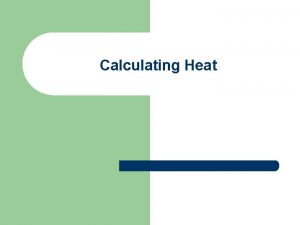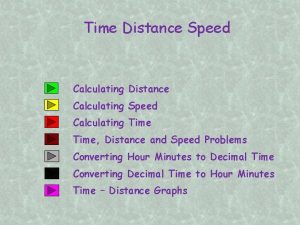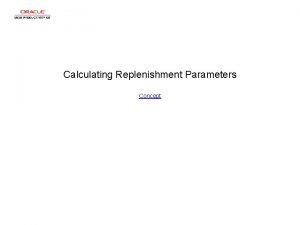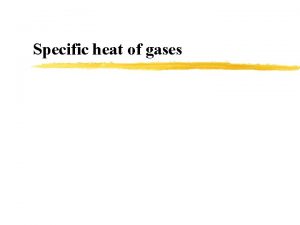Calculating energies involving specific heat capacity EXAMPLE Air
























- Slides: 24

Calculating energies involving specific heat capacity EXAMPLE: Air has a density of about = 1. 2 kg m-3. How much heat, in joules, is needed to raise the temperature of the air in a 3. 0 m by 4. 0 m by 5. 0 m room by 5°C? (c = 1050 J / kg·C°) SOLUTION: The change in temperature is given: T = 5°C. We get the mass from = m / V or m = V = (1. 2)(3)(4)(5) = 72 kg. Q = mc T = (72)(1050)(5) = 378000 J or 380 k. J.

Calculating energies involving specific heat capacity PRACTICE: Suppose we have a 200. -kg steel ingot and a 200. -kg block of wood, both at room temperature (20. 0°C). If we add 1, 143, 000 J of heat (the energy of a Snickers. TM bar) to each object, what will its final temperature be? SOLUTION: For both, Q = mc T = mc(T – T 0). Steel: 1143000 = 200(460)(T – 20) 12. 4 = T – 20 or T = 32. 4°C. Wood: 1143000 = 200(1680)(T – 20) 3. 40 = T – 20 or T = 23. 4°C.

Specific latent heat EXAMPLE: Compare boiling and evaporation. SOLUTION: Boiling takes place within the whole liquid at the same temperature, called the boiling point. Evaporation occurs only at the surface of a liquid and can occur at any temperature. Evaporation can be enhanced by increasing the surface area, warming the liquid, or having air movement at the surface. Boiling and evaporation both remove the same amount of heat energy from the liquid. This is why sweating removes excess body heat so well!

Specific latent heat EXAMPLE: Bob has designed a 525 -kg ice chair. How much heat must he remove from water at 0°C to make the ice chair (also at 0°C)? SOLUTION: In a phase change T = 0 so we use Q = m. L. Since the phase change is freezing, we use Lf. For the water-to-ice phase change Lf = 3. 33 105 J kg-1. Thus Q = m. L = (525)(3. 33 105) = 175 106 J. Bob can now chill in his new chair.

The kinetic model of an ideal gas Temperature is a measure of the EK of the gas. Reducing the EK reduces the frequency of collisions. For perfectly elastic collisions (as in an ideal gas) contact time is zero regardless of EK.

The mole and molar mass EXAMPLE: Find the mass (in kg) of one mole of carbon. SOLUTION: From the periodic table we see that it is just 1 mole C = 12. 011 grams = 0. 012011 kg.

The mole and molar mass PRACTICE: What is the gram atomic weight of oxygen? SOLUTION: It is 15. 9994 g, or if you prefer, (15. 9994 g)(1 kg / 1000 g) = 0. 015994 kg PRACTICE: What is the molar mass of phosphorus in kilograms? From the periodic table we see that the molar mass of phosphorus is 30. 973762 grams. The molar mass in kilograms is 0. 030973762 kg.

The mole and molar mass PRACTICE: Water is made up of 2 hydrogen atoms and 1 oxygen atom and has a molecular formula given by H 2 O. Find (a) the gram atomic weight of water. (b) the mass in grams of 1 mole of water. (c) how many moles of hydrogen and oxygen there are in 1 mole of water. SOLUTION: (a) The GAW of H 2 O is given by 2(1. 00794) + 1(15. 9994) = 18. 01528 g per mole. (b) Thus the mass of 1 mole of H 2 O is 18. 01528 g. (c) Since each mole of H 2 O has 2 H and 1 O, there are 2 moles of H and 1 mole of O for each mole of water.

The mole and molar mass PRACTICE: Suppose we have 12. 25 g of water in a Dixie. TM Cup? How many moles of water does this amount to? SOLUTION: We determined that the GAW of H 2 O is 18. 01528 g per mole in the previous problem. Thus (12. 25 g)(1 mol / 18. 01528 g) = 0. 6800 mol. FYI Maintain your vigilance regarding significant figures!

The Avogadro constant EXAMPLE: How many atoms of P are there in 31. 0 g of it? How many atoms of C are there in 12. 0 g of it? There are NA = 6. 02 1023 atoms of P in 31. 0 g of it. There are NA = 6. 02 1023 atoms of C in 12. 0 g of it. EXAMPLE: How many atoms of P are there in 145. 8 g of it? It is best to start with the given quantity. (145. 8 g)(1 mol / 30. 984 g)(6. 02 1023 atoms / 1 mol) = 2. 83 1024 atoms of P. EXAMPLE: A sample of carbon has 1. 28 1024 atoms as counted by Marvin the Paranoid Android. a) How many moles is this? b) What is its mass? a) (1. 28 1024 atoms)(1 mol / 6. 02 1023 atoms) = 2. 13 mol. b) (2. 13 mol)(12. 011 g / mol) = 25. 5 g of C.

Equation of state for an ideal gas Use p. V = n. RT. From T(K) = T(°C) + 273 Ti = 30 + 273 = 303 K. Tf = 330 + 273 = 603 K. Vi = Vf. pi. Vi = n. RTi, pf. Vf pi. Vi pf. Vf = n. RTf n. RTi pf = pi. Tf / Ti pf = (6)(603) / 303 = 12

Equation of state for an ideal gas For an ideal gas use p. V = n. RT. WANTED: n, the number of moles. GIVEN: p = 20 106 Pa, V = 2. 0 10 -2 m 3. From T(K) = T(°C) + 273 T(K) = 17 + 273 = 290 K. Then n = p. V / (RT) n = (20 106)(2 10 -2) / [ (8. 31)(290) ] n = 170 mol.

Equation of state for an ideal gas Use n = N / NA where NA = 6. 02 1023 atoms / mol. Then N = n NA. N = 170 mol N = 1. 0 1026 atoms. 6. 02 1023 atoms mol

Differences between real and ideal gases Under high pressure or low volume real gases’ intermolecular forces come into play. Under low pressure or large volume real gases’ obey the equation of state.

Constant pressure process – isobaric process EXAMPLE: Show that for an isolated ideal gas V T during an isobaric process. SOLUTION: Use p. V = n. RT. Then V = ( n. R / p )T. Isolated means n is constant (no gas is added to or lost from the system). Isobaric means p is constant. Then n and P are constant (as is R). Thus V = ( n. R / p )T = ( CONST )T V T. ( isobaric process )

Why do we wait before recording our values? Constant temperature process –isothermal process In an isothermal process, T does not change. EXAMPLE: A graduated syringe which is filled with air is placed in an ice bath and allowed to reach the temperature of the water. Demonstrate that p 1 V 1 = p 2 V 2. SOLUTION: Record initial states after a wait: p 1 = 15, V 1 = 10, and T 1 = 0ºC. Record final states after a wait: p 2 = 30, V 2 = 5, and T 2 = 0ºC. p 1 V 1 = 15(10) = 150. p 2 V 2 = 30(5) = 150. Thus p 1 V 1 = p 2 V 2. 10 20 0 30

Constant temperature process –isothermal process PRACTICE: Show that for an isolated ideal gas p 1 V 1 = p 2 V 2 during an isothermal process. SOLUTION: From p. V = n. RT we can write p 1 V 1 = n. RT 1 p 2 V 2 = n. RT 2. Isolated means n is constant. Isothermal means T is constant so T 1 = T 2 = T. Obviously R is constant. Thus p 1 V 1 = n. RT = p 2 V 2. ( isothermal )

Sketching and interpreting state change graphs p The three state variables of a gas (if n is kept constant) are analogous. We can plot the three variables p, V, and T on mutually perpendicular axes like this: We have made layers in T. Thus each layer has a single temperature. V T 1 T 2 T 3 T 4 T p iso th FYI Each layer is an isotherm. The 3 D graph (above) can then be redrawn in its simpler 2 D form (below) without loss of information. er m s T 2 T 1 T 3 T 4 V

Sketching and interpreting state change graphs A thermodynamic process involves moving from one state to another state. This could involve changing any or even all of the state variables (p, V, or T). EXAMPLE: In the p-V graph shown, identify each process type as ISOBARIC, ISOTHERMAL, OR A ISOVOLUMETRIC (isochoric). p is ot SOLUTION: he rm A B is isothermal (constant T). B C is isobaric (constant p). C C A is isochoric (constant V). isot D h We will only have two states erm change at a time. Phew! B FYI The purple line shows all three states changing. V

Sketching and interpreting state change graphs A thermodynamic cycle is a set of processes which ultimately return a gas to its original state. EXAMPLE: A fixed quantity of a gas undergoes a cycle by changing between the following three states: State A: (p = 2 Pa, V = 10 m 3) State B: (p = 8 Pa, V = 10 m 3) State C: (p = 8 Pa, V = 25 m 3) Each process is a straight line, and the cycle goes like this: A B C A. Sketch the complete cycle on a p-V diagram. p SOLUTION: Scale your axes and plot your points… (a) Find the work done during the process A B. (b) Find the work done during the process B C. SOLUTION: Use W = p V. (a) From A to B: V = 0. Thus the W = 0. (b) From B to C: V = 25 – 10 = 15; p = 8. Thus W = p V = 8(15) = 120 J. 8 B 2 A C 10 25 V

(c) Find the work done during the process C A. ∆V is negative when going from C (V = 25) to A (V = 10). p is NOT constant so W p∆V. 8 W = Area under the p-V diagram p B C = - [ (2)(15) + (1/2)(6)(15) ] = - 75 J. (d) Find the work done during the cycle A B C A. 2 Just total up the work done in each process. WA B = 0 J. WB C = +120 J. WC A = -75 J. Wcycle = 0 + 120 – 75 = +45 J. 10 = +[ (2)(15) + (1/2)(6)(15) ] = +75 J. WC B = P∆V = 8(10– 25) = -120 J. WB A = 0 J (since ∆V = 0). Wcycle = 75 - 120 + 0 = -45 J. V 25 p (e) Find the total work done if the previous cycle is reversed We want the cycle A C B A. WA C = Area A 8 B 2 A C 10 25 Because Wcycle is positive, work is done on the external environment during each cycle. Reversing the cycle reverses the sign of the work. V

Sketching and interpreting state change graphs Fixed mass and constant volume means n and V are constant. Thus p. V = n. RT p = (n. R/V)T p = (CONST)T. (LINEAR) Since the t axis is in ºC, but T is in Kelvin, the horizontal intercept must be NEGATIVE…

Sketching and interpreting state change graphs p = 0 at absolute zero. From p. V = n. RT: p = (1 R / V )T:

Average kinetic/internal energy of an ideal gas EXAMPLE: 2. 50 moles of hydrogen gas is contained in a fixed volume of 1. 25 m 3 at a temperature of 175 C. a) What is the average kinetic energy of each atom? b) What is the total internal energy of the gas? T(K) = 175 + 273 = 448 K. a) EK = (3/2) k. BT = (3/2)(1. 38 10 -23)(448) = 9. 27 10 -21 J. b) From n = N / NA we get N = n. NA. N = (2. 50 mol)(6. 02 1023 atoms / mol) = 1. 51 1024 atm. EK = NEK = (1. 51 1024)(9. 27 10 -21 J) = 14000 J. c) What is the pressure of the gas at this temperature? T(K) = 175 + 273 = 448 K. c) Use p. V = n. RT: Then p = n. RT / V = 2. 50 8. 31 448 / 1. 25 = 7450 Pa.
 Thermal capacity
Thermal capacity Ganggalion
Ganggalion Unit for specific heat capacity
Unit for specific heat capacity When you heat sugar what happens
When you heat sugar what happens Specific heat capacity of ice cream
Specific heat capacity of ice cream Dulong and petit law
Dulong and petit law Latent heat def
Latent heat def How to calculate specific heat
How to calculate specific heat Latent heat capacity
Latent heat capacity How to solve for specific heat
How to solve for specific heat Heat formula
Heat formula How to find the specific heat capacity
How to find the specific heat capacity Symbol of specific heat capacity
Symbol of specific heat capacity Required practical specific heat capacity
Required practical specific heat capacity Latent heat of lead
Latent heat of lead Specific heat of rice
Specific heat of rice Specific heat chart
Specific heat chart The unit of specific heat capacities
The unit of specific heat capacities Specific heat capacity of lead j/kg c
Specific heat capacity of lead j/kg c Investigating specific heat capacity
Investigating specific heat capacity Enthalpy of heat equation
Enthalpy of heat equation Specific heat capacity of lead j/kg c
Specific heat capacity of lead j/kg c Specific heat capacity of cheese
Specific heat capacity of cheese Specific heat capacity calculator
Specific heat capacity calculator Specifc heat of water
Specifc heat of water



